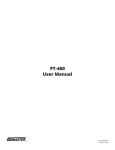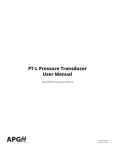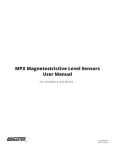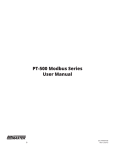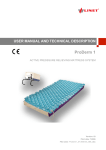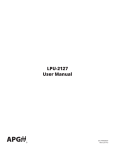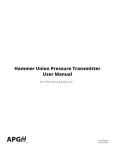Download LPU-2127 User Manual
Transcript
LPU-2127 User Manual Doc #9004169 Rev A1, 04/15 Table of Contents Introduction................................................................................................................. iii Warranty and Warranty Restrictions..................................................................... iv Chapter 1: Specifications and Options..................................................................... 1 Dimensions.........................................................................................................................................1 Specifications.................................................................................................................................... 2 Chapter 2: Installation and Removal Procedures and Notes...............................3 Tools Needed...................................................................................................................................... 3 Installation Notes............................................................................................................................. 3 Mounting Instructions.................................................................................................................... 4 Electrical Installation...................................................................................................................... 4 Removal Instructions...................................................................................................................... 4 Chapter 3: Set Up and Operation...............................................................................4 User Interface................................................................................................................................ 4-5 Operation Modes........................................................................................................................... 6-7 Calibration Modes..........................................................................................................................7-8 Utility Modes................................................................................................................................. 8-9 Chapter 4: Maintenance..............................................................................................9 General Care....................................................................................................................................... 9 Troubleshooting.............................................................................................................................. 10 Calibration........................................................................................................................................ 10 Repair and Returns..........................................................................................................................11 Chapter 5: Hazardous Location Drawing and Certification............................... 12 Hazardous Location Drawing....................................................................................................... 12 ii 402-434-9102 • www.binmaster.com • [email protected] Introduction Thank you for purchasing a LPU-2127 ultrasonic sensor from BinMaster. We appreciate your business! Please take a few minutes to familiarize yourself with your LPU-2127 and this manual. The LPU-2127 loop-powered ultrasonic sensor provides a low-power, non-contact level measurement solution rated for hazardous locations and suitable for harsh chemical environments. It offers a built-in keypad and four digit LCD display for easy setup, and a NEMA 4X cover for outdoor applications. Reading your label The LPU-2127 comes with a label that includes the instrument’s model number, part number, serial number, and a wiring pinout table. Please ensure that the part number and pinout table on your label match your order. The following electrical ratings and approvals are also listed on the label. Please request the Certificate of Compliance for further details. Electrical ratings Input: 12 to 28 Volts DC; Output: 4-20mA Class I Division 2; Groups C, D T6 Class I, Zone 2, Group IIB AEx nA IIB T6: Ta: -40°C to 60°C; IP65 Ex nA IIB T6: Ta: -40°C to 60°C; IP65 IMPORTANT: The LPU-2127 must be installed as shown on drawing 9002745 to meet listed approvals. Faulty installation will invalidate all safety approvals and ratings. 402-434-9102 • www.binmaster.com • [email protected] iii Warranty and Warranty Restrictions BinMaster warrants this product against defects in material and workmanship for two (2) years according to the following terms; 1.) This warranty extends to the original purchaser only and commences on the date of original purchase. 2.) BinMaster’s sole obligation under said warranty is to repair, or at its option replace the defective parts. The buyer shall have no other remedy. All special, incidental and consequential damages are excluded. The buyer must deliver the product under warranty prepaid to the factory. BinMaster’s obligation is limited to the cost of material and labor to repair or replace, and does not include transportation expenses. 3.) This warranty shall be voided, in our sole judgment, by alterations of equipment except by BinMaster, or tampering with, improper installation or maintenance, accident or misuse, or act of God. This warranty expressly excludes all damage to the product resulting from careless or neglectful packaging or transportation. The warranty does not extend to repairs made necessary by normal wear. 4.) This warranty is in lieu of all other warranties, expressed or implied including any implied warranties or merchantability or fitness for particular purpose. No employee, agent, franchise dealer or other person is authorized to give any warranties of any nature on behalf of BinMaster. 5) BinMaster shall in no event be responsible for any warranty work done without first obtaining BinMaster’s written consent. 6) Except as provided herein, BinMaster shall have no liability, loss or damage caused or alleged to be caused directly or indirectly by this equipment. 7) This warranty gives the buyer specific legal rights, and you may also have other rights which vary from state to state. 8) For service, please call 402-434-9102. iv 402-434-9102 • www.binmaster.com • [email protected] Chapter 1: Specifications and Options • Dimensions 4.00" 101.6 mm 6.05" 153.7 mm 2.40" 60.96 mm 2" NPT 2.30" 58.42 mm 5.50" 139.7 mm 2.00" 50.80 mm 402-434-9102 • www.binmaster.com • [email protected] 1 • Specifications Performance Operating Range 1 - 25 ft. (0.3 - 7.6 m) on liquids and hard, flat surfaces 1 - 10 ft. (0.3 - 3 m) on bulk solids Analog Output 4-20 mA Beam Pattern 9° off axis Frequency69 kHz Response Time 0.6 - 3 seconds (dependent on output range) Sample Rate 3 seconds @ 4 mA 0.6 seconds @ 20 mA Accuracy Accuracy±0.25% of detected range Resolution0.1 inch (2.54 mm) Environmental Operating Temperature -40 to 60°C (-40 to 140°F) Internal Temperature Compensation Yes Enclosure ProtectionIP65 NEMA rating4X Electrical Supply Voltage (at sensor) 12-28 VDC Current Draw22 mA max Output Signal3-30 mA max Load Resistence 150Ω max @ 12 VDC 600Ω max @ 24 VDC Cable Connection2-terminal connector Masterials of Construction Transducer HousingPVDF (Kynar®) Upper HousingPET 2 402-434-9102 • www.binmaster.com • [email protected] Chapter 2: Installation and Removal Procedures and Notes • Tools Needed Tools are not necessary for installing the LPU itself. If you are using a stand pipe to mount your LPU, you will probably need tools to install the stand pipe, but not for the LPU. • Installation Notes • Mount your LPU sensor so that it has a clear, perpendicular sound path to the surface being monitored. Your sensor should be mounted away from tank or vessel walls and inlets. See Figure 2.1. • The sound path should be free from obstructions and as open as possible for the 9° off axis beam pattern. Figure 2.1 NOTE: Do not mount the sensor where the beam will intersect objects such as fill streams, pipes, ladder rungs, wall seams, or corrugated tank walls. 402-434-9102 • www.binmaster.com • [email protected] 3 • Mounting Instructions Mounting your LPU is easy if you follow a few simple steps: • Never over-tighten the sensor. • Always screw in your sensor by hand to avoid cross-threading. Thread failure can be a problem if you damage threads by over-tightening them or by crossing threads. IMPORTANT: Do not over tighten! The sensor should be threaded in only hand tight. • Electrical Installation • • • • • With the lid of your LPU closed, remove the cable knock out. Clear the flashing. Open the lid of your LPU and intall cable gland or conduit connection. Connect 12-28 VDC supply wire to (+) Terminal Connect 4-20 mA output wire to (-) Terminal. • Removal Instructions • Remove the sensor and store it in a dry place, at a temperature between -40° F and 180° F. Chapter 3: Set Up and Operation • User Interface The LPU display and programming buttons can be accessed by loosening the screw that secures and seals the sensor’s lid. The LCD display shows the distance measurement. The display is also used to view the individual modes and their values when programming. The LPU controls operate similar to a digital wrist watch. The LPU has four buttons, MODE UP, MODE DOWN, VALUE UP, and VALUE DOWN (See Figure 3.1). The MODE UP/DN buttons allow the user to select the desired mode while VALUE UP/DN buttons allow the user to view and alter the settings. To select a mode, press the MODE UP or MODE DOWN button until the desired mode is displayed. Press the VALUE UP or VALUE DOWN button once to view the current setting of that mode. To change the selected mode setting, press the VALUE UP or VALUE DOWN button until the desired value is displayed. 4 402-434-9102 • www.binmaster.com • [email protected] To STORE or SAVE the changed mode value, press the MODE UP or MODE DOWN button once. At this point, the display will show the distance measurement. The values are stored in a nonvolatile memory, and will not be lost when power is turned off. Figure 3.1 Along with the buttons and the display, the LPU-2127 includes a detected signal strength indicator. On the leftside of the display are bars to indicate the strength of the signal returning to the sensor (See Figure 3.2). Three bars indicates excellent signal strength; two bars indicates good signal strength; one bar indicates fair signal strength; no bars indicates loss of echo (no signal). Figure 3.2 402-434-9102 • www.binmaster.com • [email protected] 5 • Operation Modes MODEDESCRIPTION PARAMETERS 1 Units Range = 0-2 Default = 0 0 = feet 1 = inches 2 = mm Mode 1 is used to select the units of measurement that will be used throughout the setup process and also for display. The units will also determine the resolution of the display and the outputs. The resolution is: feet 0.01, inches 0.1, and millimeters 1. NOTE: All modes must be set using the units selected in Mode 1. MODEDESCRIPTION PARAMETERS 2 4 mA distance Units = Mode 1 Range = 0-9999 Default = 1.00 ft. Mode 2 sets the 4 mA distance, measured from the Zero Point (See mode 10). MODEDESCRIPTION PARAMETERS 3 20 mA distance Units = Mode 1 Range = 0-9999 Default = 25.00 ft. Mode 3 sets the 20 mA distance, measured from the Zero Point (See mode 10). For Distance configuration (i.e., greater mA output for target surface further from sensor), set the mode 2 distance to be less than the mode 3 distance (See Figure 3.3). For Fill configuration (i.e., greater mA output for target surface closer to sensor), set the mode 2 distance to be greater than the mode 3 distance (See Figure 3.4). 20 ma 20 ma 4 ma Zero Point mode 2 4 ma mode 3 Max. Distance Figure 3.3 6 Zero Point mode 3 mode 2 Max. Distance Figure 3.4 402-434-9102 • www.binmaster.com • [email protected] MODEDESCRIPTION PARAMETERS 4 Response Time Range = 1-3 Default = 1 1 = 3.3 ft/min (1m/min) 2 = 15ft/min (4.5m/min) 3 = >15 ft/min (4.5/min) Mode 4 is used to select the desired response time of the sensor. The response time represents the maximum rate of change in target level that the sensor will accurately display. Thus, setting 1 (3.3 ft/min) is the slowest setting, and setting 3 ( >15 ft/min) is the fastest. MODEDESCRIPTION PARAMETERS 5 Fail-safe Range = 0 - 2 Default = 1 0 = hold last 1 = 22 mA 2 = 3.75 mA Mode 5 sets the output condition that the sensor will revert to in the event of a loss of echo condition. If this mode is set to 0, the sensor will hold the last reading until the signal is regained. If set to 1, the output of the sensor will go to 22 mA. If set to 2, the output will go to 3.75 mA. MODEDESCRIPTION PARAMETERS 6 Fail-safe Units = Seconds Delay Range = 5-9999 Default = 15 Mode 6 sets the delay, in seconds, before the output will show a loss of echo condition set in Mode 5. When this time has expired, the display and output will change to their fail-safe settings. NOTE: Most applications do not require the user to manipulate modes beyond 6. • Calibration Modes MODEDESCRIPTION PARAMETERS 7 4 mA Trim Range = 0-9999 Default = 5000 Mode 7 fine tunes the minimum current sourced on the analog output. MODEDESCRIPTION PARAMETERS 8 20 mA Trim Range = 0-9999 Default = 5000 Mode 8 fine tunes the maximum current sourced on the analog output. MODEDESCRIPTION PARAMETERS 9 Calibration Range = 0-1999 Default = 1000 Mode 9 is used to calibrate the sensor for variations in the speed of sound due to variations in atmospheres. The default of 1000 is used for most applications. Assume a decimal after the first digit. 402-434-9102 • www.binmaster.com • [email protected] 7 MODEDESCRIPTION PARAMETERS 10 Distance Offset Units = Mode 1 Range = -3.00 to 3.00 Default = 0 Mode 10 is used to change the Zero Point of the sensor. This not the zero output (4 mA) point of the sensor. The Zero Point of the sensor is the point from which the calculated distance is measured. See Figures 3.3 and 3.4 on page 6. • Utility Modes MODEDESCRIPTION PARAMETERS 11 Temperature Range = 0 - 2 Compensation Default = 1 0 = OFF 1 = ON 2 = View Temperature (degrees C)/ON Mode 11 activates or deactivates the internal temperature compensation circuit. The speed of sound changes with changes in temperature, therefore changes in temperature can affect distance measurements. These affects can be minimized by activating temperature compensation. If the mode is exited while viewing temperature, temperature compensation is turned ON. MODEDESCRIPTIONPARAMETERS 12 AutoSense Range = 0 - 1 Default = 1 0 = Manual (user controls Sensitivity and Pulses) 1 = AutoSense (sensor controls Sensitivity and Pulses) Mode 12 activates or deactivates AutoSense. When operating with this mode active, the LPU-2127 will automatically change the sensitivity and pulses to match the application. Modes 13 and 15 limit the maximum level that sensitivity and pulses can be manipulated when operating in AutoSense. Modes 13 and 15 set the sensitivity and pulses when operating in manual mode. MODEDESCRIPTIONPARAMETERS 13 Sensitivity Range = 0 - 100% Default = 100% Mode 13 sets the level of gain that is applied to the echo. When operating in AutoSense, this parameter limits the gain that can be applied to the echo. If operating in manual, this parameter sets the receive gain. When in manual mode, set the sensitivity to the minimum value that will allow the target to be reliably tracked through the full range of expected environmental conditions. 8 402-434-9102 • www.binmaster.com • [email protected] MODEDESCRIPTIONPARAMETERS 14 Blanking Units = Determined by Mode 1 Range = 0.5 -16 ft. Default = 1.00 ft. Mode 14 sets the Blanking distance, which is the zone from the sensor to a point where the first echo will be accepted. While blanking distance can be used to ignore unwanted targets -- such as welds, seams, pipe fittings, or gaskets -- between the sensor and the closest acceptable target level, such objects generally create additional reflections and echoes, which are hard to filter out. More often, Blanking distance is used for a sensor installed in a stand pipe. Because of the physical properties of an ultrasonic sensor, objects cannot be detected closer than approximately 1 foot from the face of the transducer. However, this distance varies according to how much energy is being transmitted (Mode 15) and the installation. Low pulses and soft mounting may allow target detection as close as 6 inches. MODEDESCRIPTIONPARAMETERS 15 Pulses Range = 1-20 Default = 16 Mode 15 sets the maximum number of pulses the sensor can transmit when operating in AutoSense or simply the number of pulses when operating in Manual (mode 12). The LPU emits a burst of pulses and measures the time it takes for the burst to travel to and from the target. The more pulses that are sent in a burst, the stronger the returning echo. When operating in Manual, increase the strength of the transmission by increasing the number of pulses for detecting soft targets in damping environments. In acoustically active environments or small enclosed areas, decrease the number of pulses to reduce multiple echoes. MODEDESCRIPTION 16 Software Version Mode 16 displays the software version of the LPU. MODEDESCRIPTION 17 Reset Mode 17 resets the LPU to factory default settings. Chapter 4: Maintenance • General Care Your LPU-2127 ultrasonic sensor is very low maintenance and will need little care as long as it was installed correctly. However, in general, you should: • Avoid applications for which the sensor was not designed, such as extreme temperatures, contact with incompatible corrosive chemicals, or other damaging environments. • Inspect the threads whenever you remove the sensor from duty or change its location. 402-434-9102 • www.binmaster.com • [email protected] 9 • Trouble Shooting Should you have problems with your LPU-2127, here are some troubleshooting steps. • Check the received signal strength (See Figure 3.2 on page 5). If the signal strength is low, alternately increase Pulses (mode 15) and Sensitivity (mode 13) until the signal strength improves. • Ensure Temperature Compensation (mode 11) is turned on. • Ensure AutoSense (mode 12) is turned on. • Ensure that Blanking (mode 14) is accurately set to account for any unwanted targets between the sensor and the closest acceptable target. • Calibration This procedure uses targets at known distances to calibrate the sensor’s accuracy. A wall or other large, flat object is recommended for the long range target. • Point the sensor at a target at a known distance near the maximum range of the sensor, 25’ for a single solid object (See Figure 4.1). • Adjust the Calibration value (mode 9) until the distance reading on the sensor matches the actual measured distance to the target. • Point the sensor at a target near the minimum measurement range, 1’ plus any Blanking distance (See Figure 4.2). • Adjust the Distance Offset value (mode 10) until the distance reading on the sensor matches the actual measured distance to the target. • Repeat previous two steps until no further adjustment is required. measure measure Figure 4.1 NOTE: Mode 17 will reset the LPU to factory default settings. 10 402-434-9102 • www.binmaster.com • [email protected] Figure 4.2 • Repair and Returns Should your LPU-2127 ultrasonic sensor require service, please contact the factory via phone or email. We will issue you a Return Material Authorization (RMA) number with instructions. • Phone: 402-434-9102 • Email: [email protected] Please have your LPU-2127’s part number and serial number available. See Warranty and Warranty Restrictions for more information. 402-434-9102 • www.binmaster.com • [email protected] 11 Chapter 5: Hazardous Location Drawing and Certification • Hazardous Location Drawing 12 402-434-9102 • www.binmaster.com • [email protected] 402-434-9102 • www.binmaster.com • [email protected] 13 402-434-9102 • www.binmaster.com • [email protected]


















